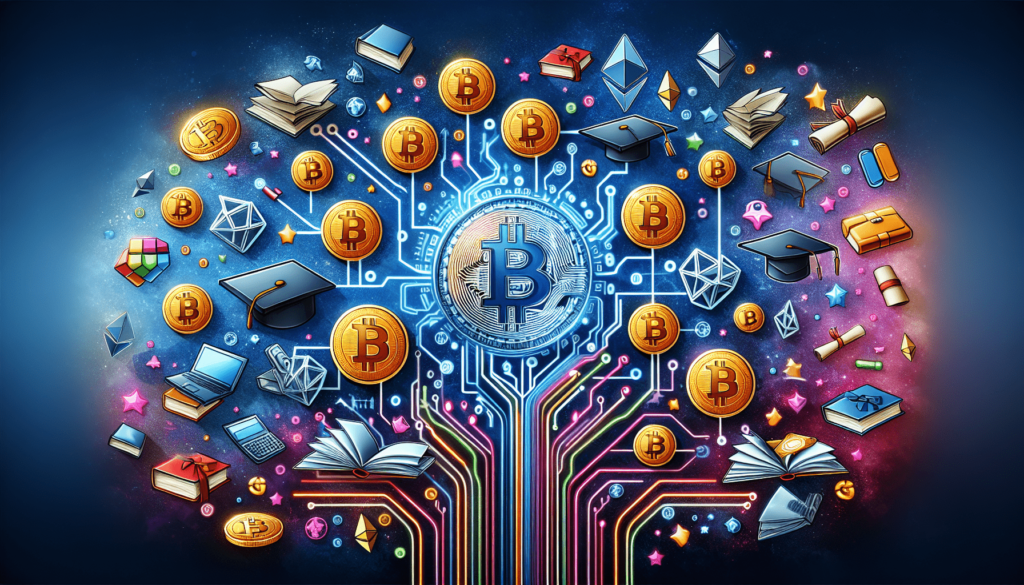Have you ever wondered how cryptocurrencies can transform the world of educational content? The exciting landscape of digital currencies is shaping various sectors, and education is certainly not left out. As educators and learners strive to navigate an increasingly digital world, the intersection between cryptocurrency and educational content promises innovative solutions that can enhance access, engagement, and the delivery of knowledge.

Understanding Cryptocurrency
Before diving into how cryptocurrencies can be used in the realm of educational content, it’s crucial to have a clear understanding of what cryptocurrency is. Cryptocurrencies are digital or virtual currencies that use cryptography for security. Unlike traditional currencies issued by governments and central banks, cryptocurrencies are decentralized and typically operate on a technology called blockchain.
What is Blockchain?
At the heart of cryptocurrency is blockchain technology. Imagine a digital ledger, or a chain of blocks, where each block records verified transactions. This ledger is distributed across a network of computers, ensuring that no single entity has control. As a result, blockchain provides a secure, transparent, and tamper-resistant way of recording transactions.
Blockchain’s decentralized nature makes it particularly appealing for educational purposes, as it offers a means to verify credentials, track learning achievements, and even issue certificates without the need for a central authority.
The Role of Crypto in Education
The incorporation of cryptocurrencies into the educational sector can be a game-changer. It opens up unprecedented possibilities for how educational content is delivered, accessed, and monetized.
Enhancing Accessibility
One of the most significant advantages of utilizing crypto in education is enhancing accessibility. Many students in remote or underserved areas face challenges in accessing quality educational resources. By using cryptocurrency, educational platforms can offer content at lower costs or even for free, reducing geographical and financial barriers.
Crypto also enables microtransactions, which can support a pay-per-content model. This means you can pay small amounts for specific lessons or modules, rather than paying for entire courses, making it more affordable and accessible.
Promoting Further Engagement
Cryptocurrency can incentivize engagement by rewarding learners with tokens for completing tasks, participating in discussions, or achieving certain milestones. These tokens can be used within the educational platform to unlock further content or even converted into other digital currencies. Such gamification techniques can boost motivation, transforming the educational experience into a more interactive and rewarding journey.
Building a Global Education Network
Cryptocurrencies facilitate cross-border transactions without the usual complications of currency conversion. This feature supports the creation of a global educational network where resources and knowledge can be shared without the constraints of traditional economic barriers. Educators from different parts of the world can collaborate and exchange ideas, enriching the educational content available to learners worldwide.

Implementing Crypto in Educational Content
Now that you appreciate the potential of cryptocurrencies in education, how do you actually implement them? There are several approaches to consider, each offering distinct benefits and opportunities.
Payment Systems for Courses and Materials
Accepting cryptocurrencies as payment for courses and materials is one of the simplest ways to incorporate them into an educational framework. For institutions, this may involve setting up a crypto wallet and integrating it into their website or learning management system. This method allows learners from around the world to access courses using a universal means of payment, breaking down traditional transaction boundaries.
Token-Based Reward Systems
Educational platforms can develop their own tokens, creating an engaging learning environment where teachers and students earn rewards. These tokens can be issued for completing certain tasks, modules, or showing exemplary performance. Over time, learners can accumulate tokens to unlock advanced courses or receive discounts on future purchases.
Here’s a hypothetical example of how a reward system might look:
| Action | Tokens Rewarded |
|---|---|
| Completing a lesson | 5 Tokens |
| Passing a quiz | 10 Tokens |
| Participating in discussions | 2 Tokens |
| Achieving a course milestone | 50 Tokens |
Credential Verification and Certification
Blockchain technology allows for the creation of secure, verifiable digital certificates. For educational institutions, this can streamline the process of issuing, verifying, and tracking academic achievements. Students can receive digital certificates that are recognized and trusted across platforms, preventing issues like certificate forgery.
Crowdfunding Educational Projects
Cryptocurrencies can also facilitate crowdfunding efforts for educational projects. Innovative ideas that require funding can attract contributions from donors around the world. Using crypto for crowdfunding is generally simpler and can reach a larger audience than traditional methods, allowing educators and learners to bring their educational visions to life.
Challenges and Considerations
While the potential benefits are significant, integrating cryptocurrencies into educational content also comes with challenges and considerations. Being aware of these can help you make informed decisions and effectively leverage crypto within education.
Regulatory Concerns
The regulatory environment surrounding cryptocurrencies varies greatly across different countries. It’s essential for educational institutions to be aware of and comply with local regulations to avoid legal issues. Understanding the tax implications of accepting crypto payments, for example, is crucial for maintaining compliance.
Security Issues
Although blockchain is inherently secure, platforms dealing with cryptocurrencies can still be vulnerable to cyber threats. Protecting digital assets and sensitive personal information requires robust security measures and continuous monitoring. Educational institutions must invest in the right security infrastructure to provide a safe environment for learners.
Volatility of Cryptocurrencies
The value of cryptocurrencies can fluctuate wildly. For educational institutions, this means that funds received as crypto payments can vary in value, posing budgeting challenges. To mitigate this risk, some institutions may convert cryptocurrencies to stable coins or fiat currency soon after payment is received.
Technological Complexity
The implementation of cryptocurrency systems often requires technological know-how that might be outside the expertise of traditional educational institutions. External partnerships with tech companies or hiring specialized personnel could be necessary, which may involve additional costs.
Future Prospects
Despite these challenges, the future prospects of using cryptocurrency for educational content are promising. As technology evolves and becomes more user-friendly, the adoption of cryptocurrencies in education is likely to grow.
Integration with Emerging Technologies
The integration of crypto with other emerging technologies like artificial intelligence (AI) and virtual reality (VR) can further revolutionize the educational landscape. AI can personalize learning experiences, while VR can create immersive educational environments. Cryptocurrencies can facilitate seamless transactions within these tech ecosystems, enhancing overall user experiences.
Democratic Access to Education
Cryptocurrencies have the potential to democratize access to education on a global scale. By breaking down financial and geographical barriers, they can offer equal learning opportunities, particularly for those in underdeveloped or economically challenged regions. This power to bridge the educational divide can lead to a more equitable world.
Developing a New Educational Ecosystem
As we become more accustomed to the digital age, the creation of a new educational ecosystem seems inevitable. This ecosystem will likely leverage blockchain and cryptocurrencies to foster transparency, collaboration, and continuous learning. Educators, learners, and institutions can all benefit from a decentralized structure that supports innovation and creativity.
Conclusion
Cryptocurrencies offer a fascinating potential to transform educational content, making it more accessible, engaging, and secure. By understanding and embracing these technologies, you can play a role in pioneering a new era in education that harnesses the power of digital innovation. While challenges remain, the prospects are exciting, with the promise of more democratized and efficient educational systems worldwide. As this field continues to evolve, it will be essential to stay informed and open to the possibilities that cryptocurrency and blockchain technology can bring to education.

